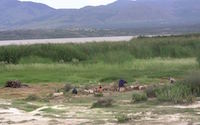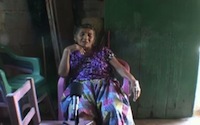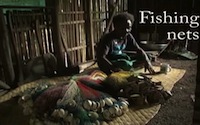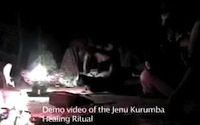Wichíis a Mataco-Mataguayan language. In Argentina, Wichí is spoken in the
provinces of Chaco, Salta and Formosa. In Bolivia, Wichí speakers are
located in the department of Tarija, on the border between Bolivia and
Argentina. The exact number of speakers is still unknown. Barabás and
Bartolomé (1979) pointed out that there might be 12,000 Wichí people in
Salta and Formosa altogether, and about 3,200 more in Chaco. García
(2002) reports that there are approximately 40,000 Wichí living in
Argentina and Bolivia.
A vernacular classification distinguishes between two groups: the
phomlheley (lit. the people who live upstream) and the chomlheley (lit.
people located downstream), following to the course of the Pilcomayo
and Bermejo (Teuco) Rivers.
The Wichí language is a predominantly suffixing language with a marked
tendency to polysynthesis. Core arguments are morphologically coded.
Like other Chaco languages, it distinguishes between inalienable and
alienable possessed nouns. There is a nominal prefix for alienable
possessed nouns which co-occurs with personal possessive prefixes. A
deictic system for referents in view/out of view is apparent in
demonstratives, nouns and verbs. Verbs consist of at least two
morphemes with up to fifteen position classes. The language has a
single paradigm of pronominal prefixes to index both transitive and
intransitive subjects. There is a separate set of suffixes to indicate
the human object. The phonological inventory is quite large, having
simple, glottalized and aspirated stops and sonorants. The number of
vocalic phonemes varies from one region to another, from five to six.
Dialectal varieties of wichí
Native speakers distinguish several dialects. They have reported that
some are mutually unintelligible. Published sources mention several
dialects of Wichí. So far, four have been recognized. Tovar (1961)
differentiated three: Vejoz, spoken in the city of Embarcación (Salta);
Guisnay, in eastern Salta (Mosconi, Tartagal, Misión La Paz) and
western Formosa (Ramón Lista county); and Noctén in Bolivia. This
classification does not offer a complete scenario of the areas where
the language is spoken. In particular, it does not account for
varieties used in the settlements along the Bermejo (or Teuco) River in
Salta (Rivadavia county), Chaco (Nueva Pompeya and El Sauzalito), and
Formosa (Pozo del Tigre, Las Lomitas, Bazán, Laguna Yema, Pozo del
Mortero and Ingeniero Juárez).
The dialect in central Formosa is more similar to the one spoken in the
settlements located by the Bermejo River in the province of Chaco.
Gerzenstein (1991) and Golluscio (1994 and 1999) have documented this
dialect in Formosa and Chaco, respectively over the past ten years.
Golluscio refers to the dialect of Sauzalito, Chaco, as “the Teuco
dialect,” pointing out that this might be a fourth dialectal variety,
not taken into account by Tovar’s classification. Our project focuses
on the documentation of the Teuco dialect since it is, technically,
still an undocumented variety. The speakers are seeking help to record
and transcribe data. The area comprises more than sixty communities
distributed between the provinces of Chaco and Formosa.
References
-
Barabás, Alicia M. and Miguel Bartolomé (1979). Un testimonio mítico de
los mataco. Journal de la Sociéte des Américanistes LXVI:125-131. -
Braunstein, José (1983). Algunos rasgos de la organización social de
los indígenas del Gran Chaco. Serie Trabajos de Etnología. Buenos
Aires: Instituto de Ciencias Antropológicas, Facultad de Filosofía y
Letras, Universidad de Buenos Aires. -
García, Miguel A. (2002). Paisajes sonoros de un mundo coherente.
Prácticas musicales y religión en la sociedad wichí. Doctoral thesis.
Buenos Aires: Facultad de Filosofía y Letras, Universidad de Buenos
Aires. Unpublished. -
Gerzenstein, Ana (1991). Una variedad oriental del mataco. In Hacia una
Nueva Carta Étnica de Gran Chaco IV. Centro del Hombre Aborigen
Chaqueño (CHACO). Formosa. 67-79. -
Golluscio, Lucía (1993). Deixis in Wichí. Paper presented at SSILA
(Society for the Study of Indigenous Languages of the Americas) Annual
Meeting, Washington, DC. - Golluscio, Lucía (1999). Clases de sustantivos
y sistema cultural: la posesión en wichí. Signo y Seña, 3:221-239.
Buenos Aires: Instituto de Lingüística, Facultad de Filosofía y Letras,
Universidad de Buenos Aires. -
Kersten, Ludwig (1986). Las tribus indígenas del Gran Chaco hasta fines
del siglo XVIII. Una contribución a la etnografía histórica de
Sudamérica. Resistencia, Chaco: Universidad Nacional del Nordeste. -
Rodríguez Mir, Javier and José Braunstein (1993-94). Sedentarización y
etnicidad. El caso de los Matacos de Las Lomitas (Argentina). Runa XXI:
263-270 -
Tovar Llorente, Antonio (1964). El grupo mataco y su relación con otras
lenguas de América del Sur. Mexico: XXXV International Congress of
Americanists.







